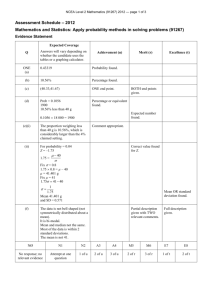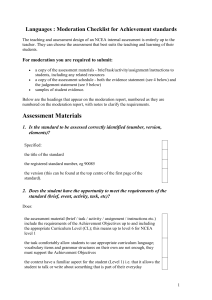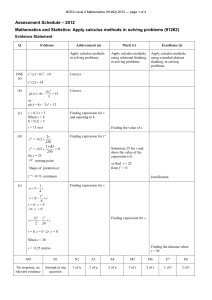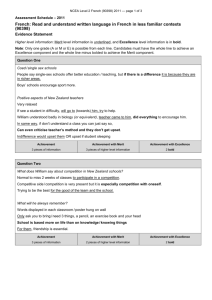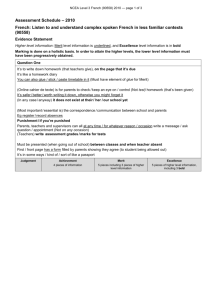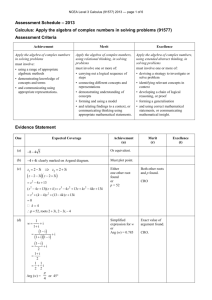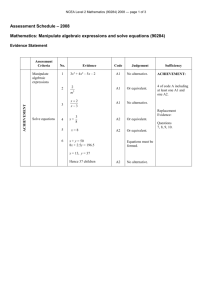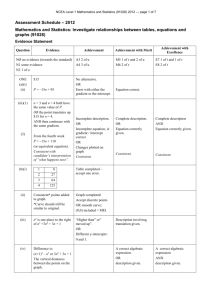Level 1 Physics (90939) 2011 Assessment Schedule
advertisement
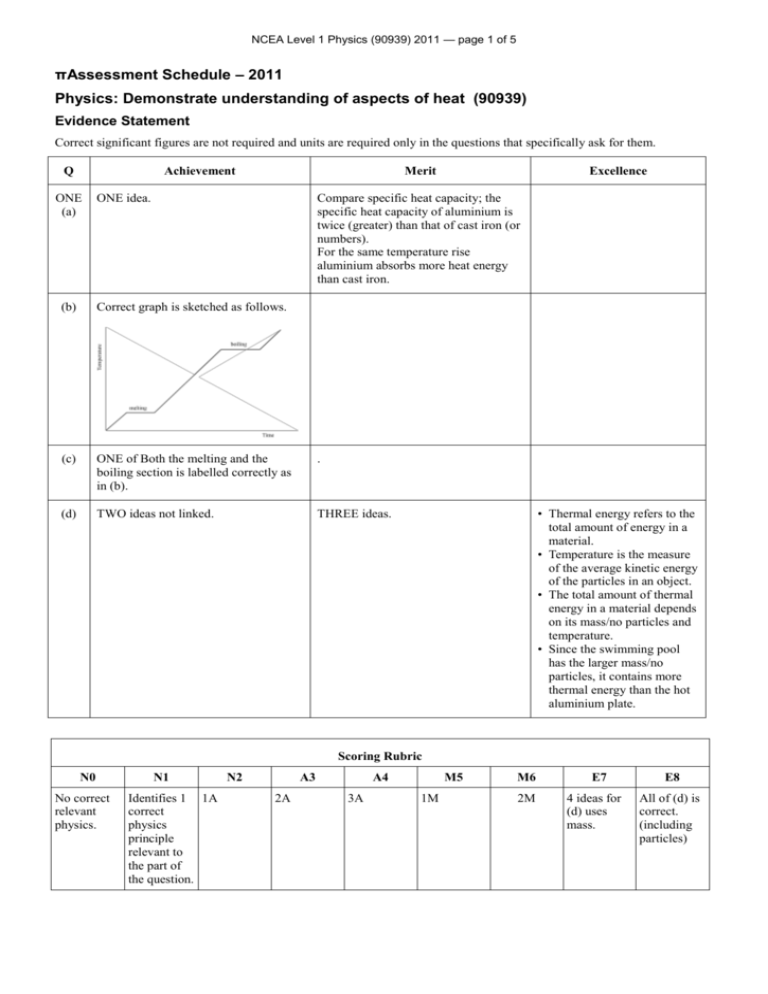
NCEA Level 1 Physics (90939) 2011 — page 1 of 5 πAssessment Schedule – 2011 Physics: Demonstrate understanding of aspects of heat (90939) Evidence Statement Correct significant figures are not required and units are required only in the questions that specifically ask for them. Q Achievement ONE (a) Merit ONE idea. Excellence Compare specific heat capacity; the specific heat capacity of aluminium is twice (greater) than that of cast iron (or numbers). For the same temperature rise aluminium absorbs more heat energy than cast iron. (b) Correct graph is sketched as follows. (c) ONE of Both the melting and the boiling section is labelled correctly as in (b). . (d) TWO ideas not linked. THREE ideas. • Thermal energy refers to the total amount of energy in a material. • Temperature is the measure of the average kinetic energy of the particles in an object. • The total amount of thermal energy in a material depends on its mass/no particles and temperature. • Since the swimming pool has the larger mass/no particles, it contains more thermal energy than the hot aluminium plate. Scoring Rubric N0 No correct relevant physics. N1 Identifies 1 1A correct physics principle relevant to the part of the question. N2 A3 2A A4 3A M5 1M M6 2M E7 4 ideas for (d) uses mass. E8 All of (d) is correct. (including particles) NCEA Level 1 Physics (90939) 2011 — page 2 of 5 Q Achievement Merit Excellence Used Q as 23.2 and got an answer of 1.974 J kg–1 °C–1. Q = m c ΔT 23 200 = 0.050 c (250 – 15) c = 23 200 / (0.50 235) =1974 J kg–1 °C–1 (b) ONE correct answer is given. Any TWO of the following answers are correct. • The wooden frame is made from an insulator so that not much heat is lost from the plate by conduction to the frame. • The hood over the barbecue traps the air above the hotplate to minimise the amount of heat lost from by convection / it reflects the heat back to reduce the heat lost by radiation. • The burner cover around the burner minimises the amount of heat lost by convection and radiation to the surroundings. (c) Q = m c ΔT Q = 1.65 897 (300 – 20) Q = 414 414 J Q = m c ΔT Q = 1.65 897 (300 – 20) Q = 414 414 J ONE correct calculation. P=E/t t=E/P t = 414 414 / 1380 t = 300 s t = 300 / 60 = 5 min Mentions heat loss to surroundings / environment Describe some heat is lost to the surroundings through specific method eg conduction through metal guard. TWO (a) (d) Describe some heat is lost to the surroundings through specific method eg conduction through metal guard. And therefore to reach 300°C heat, more energy is need, so longer time Scoring Rubric N0 No correct relevant physics. N1 Identifies one physics principle / equation relevant to the part of the question. N2 1A A3 2A OR 1M A4 3A OR 1A 1M. M5 2M M6 3M E7 E8 (d) Missing All of (d) is either correct. to reach 300°C OR more energy needed. NCEA Level 1 Physics (90939) 2011 — page 3 of 5 Q THREE (a) Achievement Merit Excellence Mentions that foam is a poor conductor of heat. The drinks are kept cool, as the foam traps air, which provides an insulating layer, reducing the transfer of heat into the bag by convection / convection. (b) The drinks are cooled down as the cooler blocks take heat from the bottles / surroundings. The drinks are cooled down as the cooler blocks take heat from the drinks, to provide the latent heat of fusion as they melt. (c) EITHER Q1 = m L OR Q 2 = m c ΔT is calculated. Correct working and answer for Q 1 = m L and Q 2 = m c ΔT, but the total is not given. Ok not converted to kg OR correct method, but calculate Q 2 = m c ΔT for lemonade (m and ΔT must match) . OR Q 2 = m c ΔT for lemonade (m and ΔT must match) (d) Mentions evaporation of water / moisture causes her body to cool. Energy needed to melt the ice Qice = m L + m c ΔT Q 1= m L = 0.035 330 000 = 11 550 J Q 2 = m c ΔT = 0.035 4 200 5 = 735 J Qice = 11 550 + 735 = 12 285 J When the breeze blows moisture / water on Amy’s skin evaporates faster. The heat (latent heat of vaporisation) required for evaporation is absorbed/lost from Amy’s body and so she feels cooler. Scoring Rubric N0 No correct relevant physics. N1 Identifies one physics principle / equation relevant to the part of the equation. N2 1A A3 2A OR 1M A4 3A OR 1A 1M M5 2M M6 3M E7 E8 Correct All of (c) is working correct. answer in seconds, but kg not converted. NCEA Level 1 Physics (90939) 2011 — page 4 of 5 Q Achievement Merit FOUR (a) They absorb sunlight / energy from the sun. (b) Mentions that the white wall will be less warm / reflect more heat / absorb less heat than the dark wall during the day. OR Comparison no link to rate of heating (c) Mentions that the walls absorb energy during the day/radiate heat during the night. Excellence The following answers are given. • The white wall reflects most of the energy because the colour white is a good reflector of radiant energy and absorbs little so will heat more slowly. • The dark wall absorbs most of the energy because the dark colour is a good absorber of radiant energy so will heat more quickly. Comparison of heat absorbed. During the day the dark wall heats up more quickly because it absorbs more energy / sunlight so it reaches a higher temperature. OR Comparison of heat radiated At night the dark wall loses heat faster/radiates heat more quickly (than the white wall). (d) Energy absorbed by 1 m2 of the tiles in one minute = 80 / 100 60 000 = 48 000 J OR Correct second step with follow on error from the first step. Comparison of heat absorbed connected to temperature. During the day the dark wall heats up more quickly because it absorbs more energy / sunlight so it reaches a higher temperature. AND Comparison of heat radiated connected to temperature. At night the dark wall loses heat faster / radiates heat more quickly (than the white wall) to reach a lower temperature. Energy absorbed by 1 m2 of the tiles in one minute = 80 / 100 60 000 = 48 000 J Q = m c ΔT 48 000 = 68 920 ΔT ΔT = 48 000 / 62 560 = 0.77°C. Scoring Rubric N0 N1 N2 A3 A4 M5 M6 E7 E8 No correct relevant physics. Identifies one physics principle / equation relevant to the part of the question. 1A 2A 3A 1M 2M. Must include (d) Gives a correct description of heat effect, both day and night, and explains the cause of different heat effects Gives a correct description of heat effect, both day and night, and explains the cause of different heat effects linked to temp. NCEA Level 1 Physics (90939) 2011 — page 5 of 5 Judgement Statement Score range Not Achieved Achievement Achievement with Merit Achievement with Excellence 0–9 10 – 18 19 – 24 25 – 32
